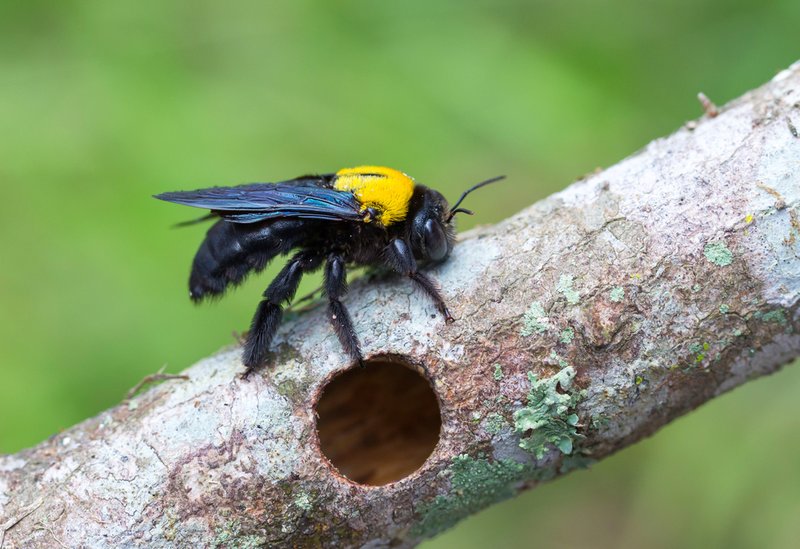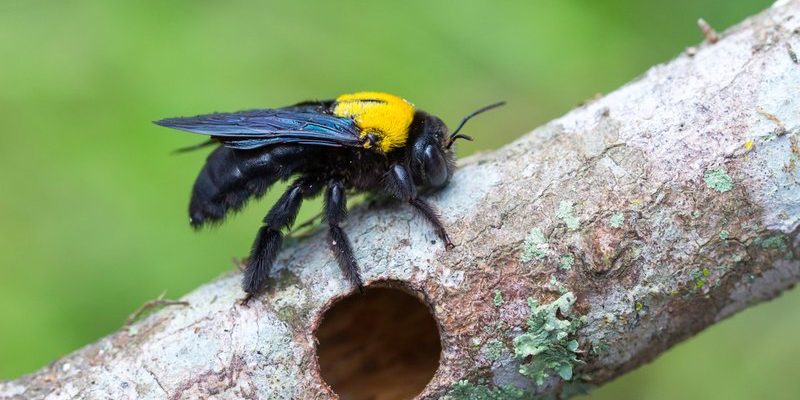
Imagine a carpenter bee as the misunderstood artist of the bee world. While they might not be as sociable as honeybees or as visually distinct as bumblebees, these solitary bees deserve a closer look. So, let’s break down some common myths about carpenter bees and uncover the truth behind these fascinating creatures.
What Exactly is a Carpenter Bee?
Before we dive into the myths, let’s clarify what a carpenter bee actually is. Carpenter bees are large, robust bees, often mistaken for bumblebees due to their similar appearance. They can be recognized by their shiny, black bodies, with some variations being fuzzy. These bees are primarily solitary and are known for their unique behavior of nesting in wood—hence their name.
Carpenter bees can be found throughout North America and are particularly common in warmer regions. They bore holes into untreated wood to create nests for their young, which can sometimes lead to concerns about damage to fences, decks, or homes. The truth is that while they can be problematic, they don’t typically cause as much damage as people think.
Myth 1: Carpenter Bees Are Dangerous and Aggressive
One of the biggest misconceptions about carpenter bees is that they are aggressive and prone to stinging. Here’s the thing: carpenter bees are generally quite docile and only sting when they feel threatened. Unlike honeybees or wasps, they don’t swarm or seek out confrontation.
In fact, males don’t even have stingers! They may fly around you or get a bit feisty if you invade their personal space, but they’re more interested in showing off than attacking. If you do happen to get a little too close for comfort, simply backing away will often solve the problem.
To sum it up: unless you’re actively trying to handle them, carpenter bees are usually pretty chill, and there’s no need to panic if you see one buzzing nearby.
Myth 2: Carpenter Bees Are Pests That Destroy Wood
Another common myth is that carpenter bees are pests that cause severe damage to wooden structures. While it’s true that they nest in wood, they aren’t nearly as destructive as some people believe. Think of them more like woodworkers than vandals.
Carpenter bees prefer soft, untreated wood, like that in fences, decks, or even the eaves of your house. They create small holes, about ½ inch in diameter, to lay their eggs. The good news is that they typically only use a small section of wood for nesting. Unless you have an extensive infestation, the damage is often minimal.
If you’re worried about your wooden structures, regular maintenance and using treated wood can help deter them. But remember, it’s not the end of the world if you find a few holes—carpenter bees are a natural part of the ecosystem!
Myth 3: Carpenter Bees Don’t Contribute to Pollination
You might be surprised to learn that carpenter bees are actually beneficial for pollination! Some people think they only care about drilling into wood, but that’s not the whole truth. They play a vital role in the ecosystem, much like other bees.
Carpenter bees are excellent pollinators and are particularly drawn to certain flowers. As they collect nectar, pollen clings to their bodies, which they then transfer to other flowers. This helps with plant reproduction and supports local agriculture. So, next time you see a carpenter bee, remember they’re not just woodworkers—they’re also hard at work in your garden!
Myth 4: They Can’t Be Controlled or Deterrence Is Futile
You might feel helpless when faced with carpenter bees, thinking there’s no way to control their presence. While it can be challenging, there are steps you can take to deter them effectively. Let me explain how you can keep them at bay.
First, prevent nesting by painting or staining wood surfaces. Carpenter bees are less inclined to drill into treated or painted wood, and this can significantly reduce their nesting. If you already have holes, you can fill them with wood putty or caulk, especially in late summer when bees are less active.
Using traps can also be an option, though it’s more of a last-resort measure. Placing bee traps around your property can help catch some of the bees without harming them.
Ultimately, a mix of prevention and dissuasion can work wonders. You don’t have to accept these bees as permanent residents.
Myth 5: All Bees Are the Same
Understanding the unique behavior of different bee species is essential, as they all contribute differently to the ecosystem. Not all bees are the same, and lumping them together can lead to misunderstandings.
Many people group carpenter bees with honeybees, but they have very different lifestyles. While honeybees live in colonies and work together, carpenter bees are solitary. They don’t produce honey and prefer creating individual nests. This individuality doesn’t mean they’re less important—in fact, their solitary nature allows them to pollinate a broader range of flowers.
Educating yourself about the various types of bees can help foster appreciation for their unique roles in nature. Each species contributes to the health of our environment, and recognizing their differences is part of understanding biodiversity.
Final Thoughts on Carpenter Bees
Carpenter bees often get a bad rap, but many of the myths surrounding them simply aren’t true. From being harmless pollinators to skilled woodworkers, these bees play a unique role in our ecosystem. Understanding their behavior and needs can help dispel fears and misconceptions.
If you live in an area where carpenter bees are common, take a moment to appreciate their contributions instead of fearing them. After all, we share this planet with these unique creatures, and fostering coexistence is more beneficial than simply considering them pests. So, next time you spot a carpenter bee, think of it as a little artist in your garden, working hard to create nests and pollinate flowers.

